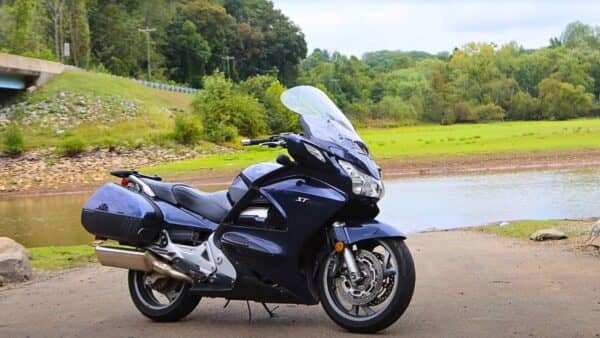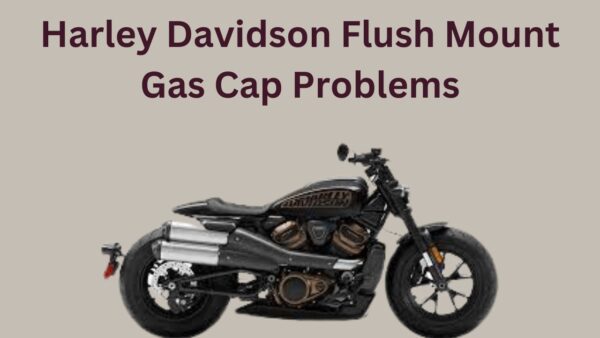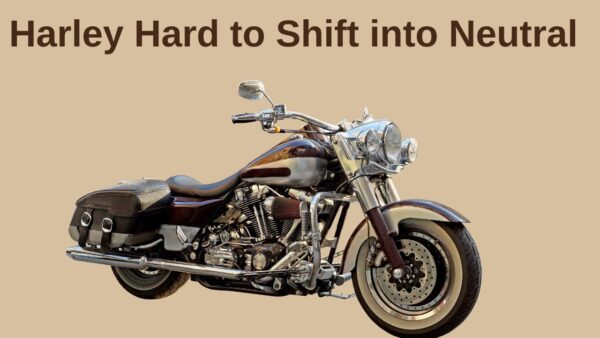The Honda ST1300, a popular touring motorcycle, is known for its ergonomic design, powerful V4 engine, and smooth ride. However, like all machines, it’s not without its share of problems.

In this article, we will dive into the common issues reported by ST1300 owners, providing an in-depth analysis of each problem and possible solutions.
Honda St1300 Problems
Some of the key issues the St1300 faced were the excessive heat generation from the engine and the premature wear of alternator drive gears.
Issues with the bodywork’s durability, specifically regarding the plastic panels’ susceptibility to damage, have also been reported.
Lastly, some riders have commented on the bike’s weight, indicating that the ST1300 might feel too heavy, particularly when fully loaded.
1. Starting Troubles
The motorcycle, like any other motorcycle, can occasionally suffer from starting troubles, which can be frustrating for riders.
While this issue can stem from various sources, the most common culprits are usually a weak battery, poor fuel quality, or a defective starter motor.
If your ST1300 is having difficulty starting, the first step you should take is to check the battery.
Ensure it is adequately charged, as a weak battery might not be able to provide enough power to start the engine.
You can use a multimeter to measure the voltage. If it shows less than 12.6V, you might need to recharge or replace the battery.
Related: Common Issues with Honda ST 1100
Next, check the quality of your fuel. Poor quality or old fuel can lead to starting problems.
If you suspect the fuel is the issue, you might need to drain the fuel tank and refill it with fresh, high-quality fuel.
Lastly, inspect your starter motor. If you hear a clicking sound when you try to start your bike, but the engine doesn’t turn over, this could indicate a starter motor issue.
In this case, you might need to have it replaced or professionally repaired.
2. Idle Complications
One of the prevalent issues that users face revolves around idle complications.
These problems manifest typically as an erratic or rough idle, where the motorcycle’s engine might rumble or shake more than usual when the bike is stationary.
In severe cases, the engine might stall entirely, causing the motorcycle to switch off.
This could be due to a dirty or clogged fuel injector, which can restrict the flow of fuel to the engine.
This issue can be resolved by running a fuel system cleaner through the motorcycle’s fuel system or, in more severe cases, manually cleaning or replacing the injectors.
Another possible cause could be a malfunctioning idle air control valve.
This component manages the engine’s idle speed and can cause problems if it’s not functioning correctly. If the idle control valve is faulty, it might need to be replaced.
It could also be due to a vacuum leak, which can lead to an unstable air-fuel mixture in the engine.
A vacuum leak can be harder to diagnose and fix, but it often involves checking and replacing any damaged hoses or seals.
3. Issues with Coolant
Some riders have reported overheating issues, which are often due to a lack of coolant.
Coolant is essential in regulating the engine temperature of the motorcycle and preventing it from overheating.
Insufficient coolant can also lead to further complications, such as a damaged radiator or engine.
To address this, regularly check the coolant levels of your motorcycle. The coolant reservoir is located on the left side of the motorcycle, under the side cover.
You can visually check the level through the sight glass. If it’s below the “Low” mark, add coolant until it reaches the “High” mark.
Use a high-quality coolant that is compatible with aluminium engines, like the Honda Type 2 coolant, which is pre-mixed and ready to use.
Avoid mixing different types of coolants, as it can lead to chemical reactions that may damage the cooling system.
4. Oil Leaks
Oil leaks in motorcycles can be a common issue, causing not only a mess in your garage but potentially leading to more significant engine problems if left unattended.
These leaks often originate from the gaskets or seals within the engine or from the oil pan itself.
To fix the issue, it’s essential to identify the source of the leak. Start by thoroughly cleaning the engine and then running the bike briefly.
This can make the leak’s origin point more apparent. Pay specific attention to the areas around the gaskets, seals and the oil pan.
If the leak is coming from a gasket or seal, replacement may be necessary.
For DIY enthusiasts, this can be a moderate to difficult task, depending on the specific gasket or seal that’s leaking.
It typically involves disassembling parts of the engine to reach the faulty component, replacing it, and reassembling.
If the oil pan is the culprit, check for any visible cracks or damage. A damaged oil pan may need to be replaced, while a loose drain plug can be tightened to resolve the issue.
Always remember to replace the crush washer during each oil change to prevent leaks from the drain plug.
5. Problems With Engine Sounds
One common issue reported by Honda owners is a peculiar engine sound.
This abnormal noise typically manifests as a high-pitched whine or a rattling noise, usually noticeable when the bike is at idle or low revs.
It could be due to a cam chain tensioner, which may wear out over time, allowing the cam chain to rub against its housing.
This can result in a distinctive rattling or clattering noise. To resolve this, you may need to replace the tensioner.
Another potential source could be an alternator drive gear, which can produce a high-pitched whining sound when worn or misaligned.
This issue is also rectifiable, but it requires disassembly and realignment of the drive gear, which can be a complex task.
If the valves are too tight or too loose, they can create abnormal engine noise.
Checking and adjusting valve clearance at regular intervals as per the manufacturer’s guidelines can resolve the issue.
6. Overheating
Overheating is a common problem faced by motorcycle users, which can severely impact the motorcycle’s performance and longevity.
This issue arises when the engine’s temperature climbs beyond the optimal range, leading to a myriad of complications.
It could be due to a malfunctioning cooling system. The coolant’s role is to absorb the engine heat and dissipate it through the radiator.
If the coolant level is low or the coolant is old and degraded, it can lead to overheating.
Regularly inspecting the coolant level and refilling or replacing it according to the correct level can resolve the issue.
Secondly, a clogged radiator could also cause overheating. Dirt, debris, and insects can block the radiator fins, preventing the necessary airflow required to cool the engine.
A faulty thermostat can also result in overheating. The thermostat controls the amount of coolant flowing through the engine.
If it’s not opening correctly, it can restrict the coolant flow, causing the engine to overheat. If the thermostat is the issue, replacing it is typically the best solution.
Lastly, engine oil also plays a crucial role in engine cooling. Low or degraded engine oil can lead to increased friction and heat production.
7. Instability Issues
One notable issue with the Honda ST1300 is the instability it exhibits at higher speeds.
This can be characterized by a wobble or weave that is particularly evident when the motorcycle is cruising at highway speeds or during rapid acceleration.
This instability can become potentially dangerous, particularly for inexperienced riders.
It could be due to the weight distribution of the motorcycle. The ST1300 carries a significant portion of its weight up high, which can potentially lead to a feeling of instability.
The design of the fairing and windshield can contribute to aerodynamic instability.
At high speeds, wind resistance increases significantly, and any imperfections in aerodynamics can be magnified, leading to wobble or weave.
Incorrect tire pressure can result in a loss of stability, particularly at high speeds.
It is essential to regularly check and adjust tire pressure to ensure it matches the manufacturer’s specifications.
8. Backfiring Problems
One common issue that St 1300 owners report is the problem of backfiring, an explosive sound that can be startling and, in extreme cases, harmful to the motorcycle’s engine.
Backfiring occurs when the motorcycle’s engine has an unburnt fuel-air mixture that ignites in the exhaust system instead of the combustion chamber.
This can result from a lean fuel mixture, timing issues, or a poorly functioning exhaust system.
To diagnose and fix the backfiring issue, follow the steps below:
A clogged air filter can lead to a rich fuel mixture, which can cause backfiring. Replace the air filter if it’s dirty or blocked.
Ensure there are no leaks and the fuel injector is working properly. A leaking fuel system can lead to a lean fuel mixture, triggering backfires.
Incorrect ignition timing can also cause backfires. Use a timing light to ensure the spark is occurring at the correct time.
A leak in the exhaust system can let fresh air enter and ignite unburned fuel, causing a backfire. Look for any cracks or holes in your exhaust pipe and ensure the seals between the components are intact.
9. Battery Depletion Concerns
The issue can cause a weak start or, in more severe cases, an inability to start the motorcycle at all.
It can be due to frequent short rides without allowing the bike to fully warm up.
The motorcycle’s charging system needs a certain amount of time to recharge the battery after the initial start, and short rides don’t provide enough time for this.
An old or malfunctioning charging system can result in battery depletion.
If the alternator or regulator/rectifier is not properly functioning, the battery will not charge as it should.
Parasitic drain can also lead to battery depletion. It can happen when electrical accessories or systems continue to draw power from the battery, even when the motorcycle is off.
To fix the issue, ensure:
- Ensure that you ride your motorcycle for longer periods, allowing the charging system ample time to recharge the battery.
- Regularly check and maintain the charging system. Look for signs of wear and tear and ensure proper connections.
- Investigate for any potential parasitic drains. This could involve checking all electrical systems and accessories to ensure they turn off as expected when the bike is not in use.
10. Loss of Power
In some instances, owners experience a noticeable loss in power while operating their motorcycles.
This issue can be due to an issue with the fuel system. The ST1300 uses a fuel-injected engine, and if the injectors are dirty or clogged, it can lead to inefficient fuel delivery.
Secondly, the air filter might be dirty or clogged, which can restrict airflow to the engine, thereby affecting the fuel-air mixture necessary for combustion.
There could also be an issue with the spark plugs. Worn-out or fouled spark plugs can cause incomplete combustion, which would result in a power loss.
Lastly, if the motorcycle has been stored for a long period without being operated, stale fuel might be present in the system.
This could lead to a loss in power because stale fuel doesn’t combust as efficiently as fresh fuel. In such cases, it’s recommended to drain the old fuel and refill it with fresh fuel.
11. Heavyweight Bikes
The ST1300, a touring motorcycle, is known for its solid build and durability. However, one common criticism often raised by riders relates to its substantial weight.
Weighing in at approximately 730 pounds when fully gassed, the ST1300 is indeed on the heavier side compared to many motorcycles in its class.
The bike’s heft can be felt while manoeuvring at lower speeds, particularly in urban areas where frequent stops and quick turns are common.
It can also pose challenges when parking or navigating on uneven surfaces.
However, this weight also contributes to its stability at high speeds and overall road presence.
Don’t forget to check out the problems if you own NC750X, NC700X & 2002 Goldwing

Ahtsham Younas is a passionate blogger and content writer. He loves to ride motorcycles and learn the mechanical process behind the motorcycles.
He has been writing articles in the motorcycle industry since 2019 and has learned many things about motorbike niches.


